Every other Monday throughout the summer and fall while locally raised produce is spectacular and abundant, the Heavy Table will be exploring vegetarian cuisine, both in the kitchen and at local eateries. Read other stories in this series.
I love cookbooks. Well, books of all kinds, really. I love the cool, smooth feel of paper and the smell of fresh ink. I especially love dusty old family cookbooks, with their brittle and stained pages and penciled-in markings. But, mostly, I love the potential every new book holds to change my world or, at least, my perspective, and to transport me to somewhere new and exotic for a brief visit. I read cookbooks like novels. At my house you’ll find them on my nightstand, tucked under my bed, pushed under the sofa, and piled in a stack on the floor in front of my bookshelf, waiting to be reshelved.
So, when I saw seasonal and local cookbooks sprouting in bookstores everywhere this past spring, I couldn’t wait to explore them all once our local growing season kicked into gear. Between six recipe testers and tasters, we tested 28 recipes from six books, never fewer than three recipes from any one book. I personally tested no fewer than two recipes from each book, and usually four or five. I hadn’t bought this much butter and Parmesan cheese in years. I also read all 1,715 pages of text. While many of the books have a vegetable focus, none has a strictly vegetarian focus. Nevertheless, we focused our efforts on testing vegetarian recipes from the books. I had intended to declare one book the winner above all others, but found, in the end, that the best book is the one that suits your particular tastes and needs. Therefore, I’ve summarized the key qualities of each book, listed in alphabetical order below, so you can decide which one suits you.
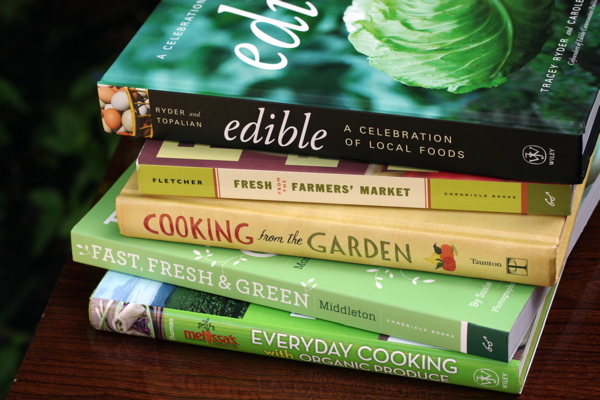
Cooking from the Garden: Best Recipes from Kitchen Gardener, edited by Ruth Lively [300 pages, hardcover, The Taunton Press, $29.95]
Cooking from the Garden is a compilation of 200 recipes from now-defunct Kitchen Gardener magazine that includes recipes from renowned chefs and authors such as Deborah Madison, James Beard Foundation Award winning author of Vegetarian Cooking for Everyone; Chicago-based chef and cookbook author Rick Bayless; and Minneapolis-based chef Lucia Watson and food writer Beth Dooley.
Two of the five recipes we tried, Lynn Alley‘s Strawberry Smoothie and Nan Wishner’s Crustless Vegetable Quiche turned out to be real favorites. The strawberry smoothie, though basic, has turned into a morning staple in the household that tested it, using peaches now instead of strawberries. The quiche made use of a good amount of garden vegetables, including kale, red onion, carrot, and potatoes, and got an appealing kick from Chinese five-spice powder which, especially when ground from scratch, is the star of the dish.

We also tried Beth Dooley’s and Lucia Watson’s White Bean Salad with Rosemary-Balsamic Vinaigrette (see recipe below) and thought it was pretty good, a B or a B+, though I wanted to add a splash of acid, apple cider vinegar, or lemon, perhaps. We didn’t use the optional homemade croutons, so perhaps that would have provided the missing element had we tried it. Unfortunately, the recipe was missing some clarification in the ingredient listing, which called for “4 cups cooked — or white beans,” which we decided meant 4 cups of cooked white beans. No directions were provided for cooking the beans, so we used our own method.
We also tried Rosemary Campiformio‘s Carrot-Top Soup (recipe below) because I never know what to do with the lovely carrot tops that come affixed to my lovely CSA carrots and I hate banishing them to the compost outright. We were pleasantly surprised and found the soup both carroty and buttery.
I found the index a little lacking, finding it difficult to even find recipes I already knew were in the book. The Crustless Vegetable Quiche is not listed under “Q” for quiche, but “E” for eggs. Not impossible, but not as robust as it could be.
This book, though, is the kind you flip through and slap Post-it notes on about every third page, because the recipes are so enticing. The sidebars are interesting, too.
Organized by: Course, from starters, snacks, and drinks to desserts.
Photos: None.
Vegetarian recipes: Many, as a result of the book’s vegetable focus. Some substitution may be required.
Noteworthy features: Includes nutritional information for each recipe. Contains a chapter on preserving, plus numerous helpful sidebars such as “Passion for pesto” and “Caring for a wooden salad bowl.” Many recipes have been contributed by noted authors or chefs, including Deborah Madison and Minneapolis Chef Lucia Watson and food writer Beth Dooley.
The bottom line: Very appealing collection recipes, many of them vegetarian or easily adapted to be vegetarian.
Edible: A Celebration of Local Foods, by Tracey Ryder and Carole Topalian [336 pages, hardcover, Wiley Hardcover, $29.95]
Part cookbook, part collection of profiles of North American (US and Canada) local culinary “heroes,” including farmers, fisherman, chefs, and artisans, Edible is a collection of stories and 80 seasonally and locally focused recipes from various contributors to the Edible regional food magazines. You can usually find Edible Twin Cities in racks crowding the entryways of coffee shops in Minneapolis and St. Paul.
The profiles comprise the first half of the book, which is organized by region (including the Midwest), while recipes comprise the second half. Each regional section begins with a brief discussion of the culinary influences and trends, then launches into a collection of essays. The Midwest section features about a half a dozen essays, including one about Laurie McCann Crowell, proprietor of St. Paul’s Golden Fig Fine Foods, and another about Lucia Watson, proprietor of Minneapolis’s Lucia’s — both written by Minneapolis-based Vina Kay. They give a shout-out to Lenny Russo’s Heartland restaurant, though they erroneously refer to it as “Heartlands,” as well as to Trotter’s Cafe and Bakery, and Native Harvest Wild Rice, among other “People, Places, Things” of note.
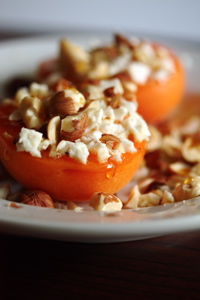
I was disappointed that none of the recipes were contributed by Edible Twin Cities — most of the Midwest recipes were contributed by Edible Iowa River Valley.
We tried four recipes from the book with mixed success: Rhubarb Bread Pudding with Whiskey Sauce, Roasted Cauliflower with Golden Raisins and Pine Nuts, Double Spoon Corn Bread, and Grilled Apricots with Blue Cheese and Hazelnuts. The Rhubarb Bread Pudding was generally successful, although there were debates about whether it was too sweet or not sweet enough: It depends on how much you like rhubarb and how potent your rhubarb is, though no guidance was given for how to determine or adjust for this. The recipe is vague in some places. For instance, it would have been nice to know approximately how much cinnamon bread makes 5 cups — is that a half a loaf or half a pound or what? (Turns out it’s about one-third a loaf of cinnamon bread.)
The Roasted Cauliflower and Grilled Apricots were successful, whereas the Double Spoon Corn Bread turned out, as described — accurately — in the recipe notes, to be souffle-like, rather than breadlike, which appealed to some, but not others.
Not as vegetable-focused as some of the other books we looked at, this book is really more about celebrating the uniqueness of the culinary regions of the US and Canada, and it does that nicely.
Organized by: Region of the US (and some of Canada) for the producer profile half of the book and by season for the recipe half of the book.
Photos? In the recipes section, yes, of select dishes.
Vegetarian recipes: Some, though many recipes featuring regional and sustainable meat, seafood, and poultry are included.
Noteworthy features: Each regional section contains several producer or chef profiles and a listing of five notable “People, places, things.”
The bottom line: Interesting profiles. Very local focus; you are encouraged to substitute ingredients that are local to you. Fewer recipes than the other books.
Farm to Fork: Cooking Local, Cooking Fresh, by Emeril Lagasse [312 pages, softcover, HarperStudio, $24.99]
If you’re expecting a lot of “BAM!” and “Yeah, baby” from Emeril Lagasse, you won’t be disappointed, even though there doesn’t appear to be even one “BAM!” in the entire book. Nevertheless, the introduction to the book and the headnotes to the recipes are conversational and homey and exude the Emeril we see on TV, though one wonders how Chef Lagasse finds time to write all these cookbooks himself.
We tried five recipes from the book: Rhubarb Strawberry Crisp; Bay, Thyme, and Rosemary Roasted Potatoes; Wilted Chard with Walnut Pesto and a Balsamic Reduction; Farmer’s Market Frittata; and Quinoa with Toasted Pecans.
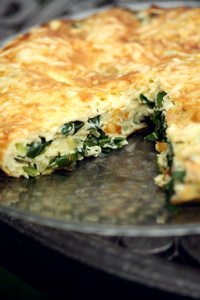
We got great results from them all, except that three of four savory recipes we tried were overly salty, including the potatoes dish that one of our tasters deemed inedible after a few bites. The fourth savory recipe specified “salt to taste.” Otherwise, the Rhubarb Strawberry Crisp was both sweet and tart, and very pretty. The Bay, Thyme, and Rosemary Roasted Potatoes were golden and lightly crispy without a hard crust. The Wilted Chard had a wonderful complex balance of sweet and acidic and was quick and easy to prepare. The Farmer’s Market Frittata (see recipe below), which Lagasse says can be adapted to substitute for chopped vegetables you have on hand, cup for cup, made great use of our CSA overload of scallions. The quinoa recipe wasn’t extraordinary, but it was quick, easy, and healthful. I appreciated that quantities were given in both weights and measures when appropriate and the directions were very clear and descriptive.
Not particularly vegetable-focused, but this is a solid cookbook, as long as you mind the salt.
Organized by: Categories of ingredient (e.g., herbs, nightshades, or grains).
Photos? Yes, of select dishes.
Vegetarian recipes: Some, though there are also chapters included for “fresh off the dock” (seafood) [note, he doesn’t mean “fresh off the dock at the lake cabin” — most of these recipes will require a trip to Coastal Seafoods or someplace similar] and “out on the range” (meat and poultry).
Noteworthy features: Contains recipes for making your own cheese and creme fraiche.
The bottom line: Complex flavors, consistent results. Recipes often too salty.
Fast, Fresh & Green: More than 90 Delicious Recipes for Veggie Lovers, by Susie Middleton [224 pages, softcover, Chronicle Books, $24.95, 2010]
Written by the former editor of Fine Cooking Magazine, this book is practically a seminar on vegetable cooking techniques, with the added bonus of recipes thrown in, including a basic “foundational” recipe for each technique. A champion for fresh vegetables, Middleton suggests that the best way to become a vegetable expert is to acquire them from different sources — farmers markets, grocery stores, and your neighbor’s garden — and employ different cooking techniques. “You’ll begin to learn what sources to trust. And you’ll begin to understand why people like me jump up and down and beg you to buy the freshest vegetables possible.” Middleton writes in a breezy conversational tone so that you hardly notice how much information she’s throwing at you. In one chapter she writes: “In my next life, I’m going to be a vegetable cheerleader and stand on the kitchen sidelines, jumping up and down chanting ‘Stir-Fry! Stir-Fry! Stir-Fry!'”
We tried five recipes from this book and, except when we forgot to peek at the foundational recipe, found them all winners. The Foil-Grilled Corn on the Cob with Maple Butter (recipe below) will get a lot of use in my household this summer, though I plan to experiment with flavored butters other than maple. The Sweet Potato “Mini-Fries” with Limey Dipping Sauce and Spiced Salt (recipe below), with its brilliant technique of cutting the potatoes width-wise instead of length-wise, is my new go-to method. The Quick Collard Greens, Confetti-Style, was simple and delicious and made me feel ashamed for having pushed the collards to the back of the fridge all of these years.
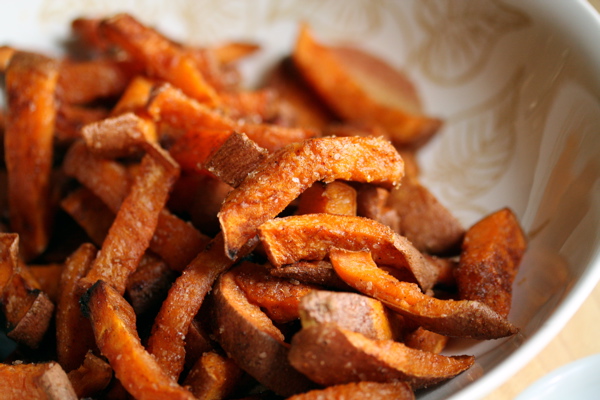
Overall, this book was my favorite of the ones I tried.
Organized by: Cooking method, from quick-roasting to grilling. Each chapter begins with an introduction to the featured cooking technique that explains how it works, which vegetables are particularly well-suited for that technique, and what special equipment or tools are needed, if any. Then a streamlined foundation recipe is provided, which is followed by more elaborate recipes.
Photos? Yes (bright and beautiful), of select dishes.
Vegetarian recipes: Many, about 75 percent of the book’s 90 recipes according to the author, as a result of the book’s vegetable focus. Some substitution may be required.
Noteworthy features: Contains a fairly robust pantry section on how to stock your pantry. Also, measurements are occasionally given in multiple forms (pounds and grams) or by weight and the number of items (e.g., 2 small sweet potatoes).
The bottom line: Cheerful and upbeat. You’ll feel like you’ve graduated from a cooking clinic rather than just cooked from a bunch of recipes.
Fresh from the Farmers’ Market: Year-Round Recipes for the Pick of the Crop, by Janet Fletcher [207 pages, softcover, Chronicle Books, $19.95]
Somehow, probably as a result of my typical approach to life of trying to do too much all at once, I ended up with this book — first published in 1998 and re-released in 2008 — instead of Janet Fletcher’s (James Beard Award winning food writer from the San Francisco Chronicle) most current book with Sur La Table: Eating Local: The Cookbook Inspired by America’s Farmers. But, they sent it, so I cooked from it.
When I used it the way I normally use cookbooks — flip to the index, look for the ingredient I have on hand, then choose a recipe — I found the book difficult to follow. The recipes are organized by season, but, as Fletcher writes, “fruits and vegetables rarely fall neatly into one season […] So, to deal with this slippery business of season, I have made some assumptions about when fruits and vegetables are likely to be at their best in most areas. For items that straddle seasons or available much of the year, I’ve placed them in the seasonal chapter that corresponds, I believe, to when they are most inviting.” This approach, for instance, lands apricots in the spring chapter, whereas apricots, in my mind, are solidly a summer fruit.
However, if read from cover-to-cover novel style, this is a warm and charming book, where Fletcher’s passion for the produce gently shines. Each seasonal chapter begins with a blurb about the season and each item of produce Fletcher has included in that season, including selection and storage techniques, which are often provided by local farmers (this is where the book tends to lean towards being California-centric). However, many of the storage tips begin with an admonition against storage, such as for cauliflower: “Take your cauliflower home from the farmers’ market and eat it that night, recommends grower Andy Griffin of California’s Happy Boy Farms. Cauliflower will last several days in the refrigerator in a plastic bag, but it will never taste better than the day you buy it. ‘People are always coming and telling me how long something lasted,’ says Griffin, ‘and I think, ‘Why?’ Eat it! One of the nicest things about farmers’ markets, to my mind, is the possibility of getting something fresh. If you buy it fresh but sit on it for a week, you’ve lost the best thing it had.'”
In fact, Fletcher’s storage suggestions are so thoughtful and thorough that this book is now my go-to for storage suggestions.
We tried a few of the 75 recipes from this book, all successful, even the “Penne with Broccoli Sauce,” which my husband called “a crime against broccoli,” as he watched in horror while I stuffed our first broccoli of the season into a pot of boiling water, then into the food processor. It tasted great, but we agreed that this would only be something you’d do if you had too much broccoli. Really, it’s just a reminder that you can turn many herbs and vegetables into pesto if you have an overload.
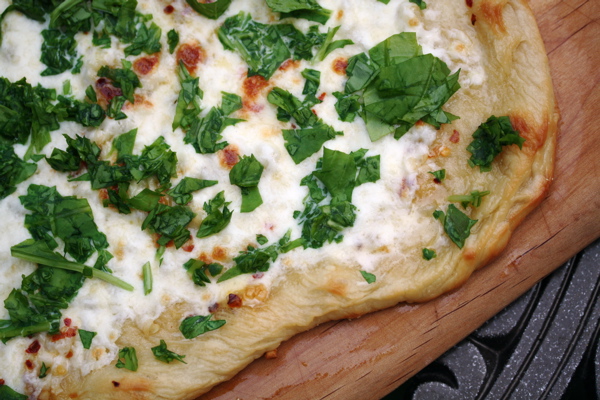
We also loved the Pizza with Mozzarella and Arugula (recipe below), even though I wanted to brush my olive oil / garlic / red pepper flake topping on the dough directly instead of drizzling it over the cheese as per the directions.
This book, with its meandering, unhurried pace, is lovely, if you take the time to read it.
Organized by: Season, then alphabetically by produce.
Photos? Yes, of select dishes.
Vegetarian options: Many, as a result of the book’s vegetable focus, but frequent of substitution (of vegetable stock for chicken stock, for instance) may be required.
Noteworthy features: Contains tips for farmers market shopping and very specific selection and storage tips.
The bottom line: Meandering and passionate with lovely images, just like an afternoon at the market. A little California-centric.
UPDATE: read our review of Eating Local: the Cookbook Inspired by America’s Farmers.
Melissa’s Everyday Cooking with Organic Produce: A Guide to Easy-to-Make Dishes with Fresh Organic Fruits and Vegetables, by Cathy Thomas [336 pages, hardcover, Wiley Hardcover, $29.95]
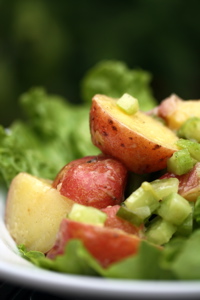
This book, written with Melissa’s (a California-based distributor of organic produce), is the workhorse of the bunch. All of the recipes we tried (the book has 400 in total) were competent, solid B’s, but none truly wow’d us. We tried the Potato and Celery Salad, the Ricotta-Stuffed Peaches, the Vinaigrette, and the Spicy Grilled Corn on the Cob with Parmesan. The latter might have become a favorite around our house if I hadn’t loved the Grilled Corn from Fast, Fresh & Green more. With Melissa’s recipes, I found myself always wanting to add a little something extra, a pinch of red pepper flakes, a squeeze of lemon, an extra handful of chopped celery. But, it was almost always the most reliable in terms of using up the produce I had on hand and had some of the most practical, quick, and easy everyday kinds of recipes. It was also the most vegetarian-friendly book in the bunch, with “meatless” tips included for most meat-based recipes in the book.
One thing that was unhelpful with this book was the seasonal organic produce chart at the front. Because Melissa’s is a distributor of produce, their perspective is that many produce items that I think especially shine when in season are “year-round” — asparagus and cucumber, for instance.
Organized by: Fruit or vegetable (56 in total), alphabetically. Each chapter begins with a discussion of the challenges or benefits of organically grown produce, then contains buying, storing, and preparation tips. Four quick “serving suggestions,” almost mini recipes, are provided, followed by four more formal, structured recipes.
Photos? Yes, of each featured produce item and of select dishes.
Noteworthy features: Many. Most recipes that are not vegetarian include a “meatless tip” for adapting the recipe.
Noteworthy feature: Nutritional information is included for each recipe.
The bottom line: Workhorse. A book you can really use every day.
THE RECIPES
I’ve picked some of my favorite recipes from the books to share. There were other great recipes we tried, but those recipes featured ingredients that are now out of season or that are not vegetarian. I’ve made some minor formatting changes, including numbering the steps in cases where the authors did not do so, but otherwise the headnotes to the recipes, ingredient lists, and directions are as they appeared in the books.
White Bean Salad with Rosemary-Balsamic Vinaigrette (From Cooking from the Garden: Best Recipes from Kitchen Gardener, edited by Ruth Lively. Recipe by Beth Dooley and Lucia Watson) [see photo in Cooking from the Garden section above]
For this flavorful salad, toss the beans with the vinaigrette while they are still hot from cooking. Let the beans cool, and then add the rest of the ingredients. The salad tastes even better the second day. The dressing keeps for several days in the refrigerator, so it can be made ahead.
Serves 6: 370 calories, 19 g fat, 380 mg sodium
For the vinaigrette:
¼ c balsamic vinegar
2 tbsp red-wine vinegar
2 cloves garlic
1 tbsp freshly cracked pepper
Dash of hot sauce
Dash of Worcestershire sauce [we at the Heavy Table used vegan Worcestershire sauce]
1 tbsp chopped fresh rosemary
½ c extra-virgin olive oil
For the salad:
4 c cooked white beans
2 c mixed, diced, blanched vegetables, such as carrots, green beans, and broccoli
2 c diced raw vegetables, such as scallions, cherry tomatoes, and bell peppers
1 tbsp chopped fresh rosemary
1 tbsp chopped fresh parsley
2 tbsp chopped fresh mint
2 tbsp chopped fresh basil, plus extra for garnish
Salt and freshly ground pepper
Salad greens
Grated Pecorino Romano, optional
1. To make the vinaigrette, whisk together the ingredients in a medium bowl and set aside.
2. To make the salad, in a large bowl, toss together the beans and the blanched and raw vegetables with the dressing, the fresh herbs, a couple pinches of salt, and a few grinds of black pepper.
3. Turn onto a large platter or individual plates lined with salad greens. Garnish with extra chopped fresh basil and grated cheese.
NOTE: Homemade croutons are a wonderful addition to this salad.
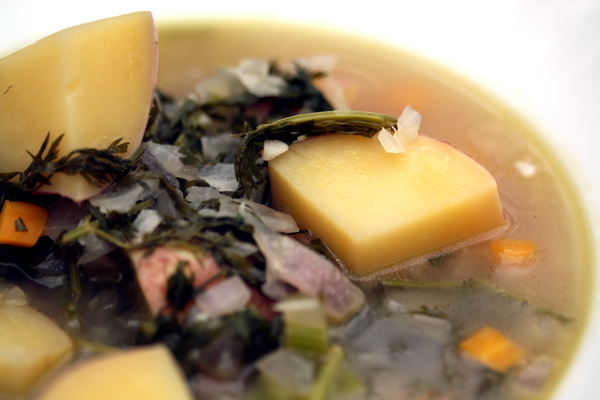
Carrot-Top Soup (From Cooking from the Garden: Best Recipes from Kitchen Gardener, edited by Ruth Lively. Recipe by Rosemary Campiformio)
If you grow carrots or buy them with tops on, don’t just toss the greens; they’re full of flavor and nutrients and make for a delicious soup.
Serves 6, 260 calories, 16 g fat, 390 mg sodium
½ c butter
1 ½ c chopped carrot tops, firmly packed
6 cloves garlic, minced
1 large red onion, diced
4 large potatoes, peeled and cut into ¾-inch chunks
½ tsp salt
½ tsp freshly ground pepper
1 stalk of celery, diced
2 carrots, diced
4 c chicken stock or water
1. Melt the butter in a large saucepot over medium heat.
2. Add the chopped carrot tops, garlic, onion, potatoes, salt, and pepper. Saute over medium heat for 10 minutes, stirring frequently to avoid sticking.
3. Add the celery and carrots and continue cooking for an additional 1 minute. Pour in the stock and bring the mixture to a boil. Immediately reduce the heat to a simmer and continue cooking until the vegetables are tender. Add more salt and pepper to taste, and serve immediately.
Farmer’s Market Frittata from Farm to Fork: Cooking Local, Cooking Fresh by Emeril Lagasse [see photo in the Farm to Fork section above]
Breakfast, brunch, lunch, or dinner? And anywhere in between: Eat a frittata. You can easily substitute other chopped vegetables, cup for cup, for the filling ingredients here. You could also use leftover cooked ingredients such as potatoes, kale, or spinach: Chop them small and warm them in the pan with the other ingredients just before you add the eggs.
Serves 6
8 eggs
3 tbsp heavy cream
½ tsp salt
¼ tsp freshly ground black pepper
3 tbsp butter
1 c thinly sliced onions
1 c thinly sliced yellow, red, or orange bell peppers, or a mix
1 c thinly sliced mushrooms (about 4 oz)
1 c fresh corn kernels
1 c diced smoked ham
2 tbsp chopped fresh herbs, such as chives, basil, thyme, parsley, oregano, or your favorite mixture
1 c grated Swiss cheese (about 4 oz)
1. Set a rack in the upper third of the oven and preheat the broiler.
2. In a small bowl, whisk the eggs, cream, salt, and pepper together until combined.
3. Melt 2 tablespoons butter in a 10-inch oven-proof saute pan over medium-high heat. Add the onions and peppers and cook, stirring as needed, until soft, 7 to 8 minutes. Add the mushrooms and corn and cook for 2 minutes. Add the ham and cook until warmed through, 1 minute. Add the remaining 1 tablespoon butter, and when it has melted, add the egg mixture. Sprinkle the fresh herbs over the eggs, and top with the grated cheese. Reduce the heat to medium and cook the eggs, undisturbed, for 3 minutes, or until the surface begins to bubble and the bottom starts to set.
4. Immediately place the saute pan in the oven and broil until golden brown on top, 3 to 4 minutes.
5. Remove the pan from the oven. Using a rubber spatula, loosen the frittata from the sides of the pan. Tilt the pan and gently slide the frittata onto a platter. Serve hot or warm.
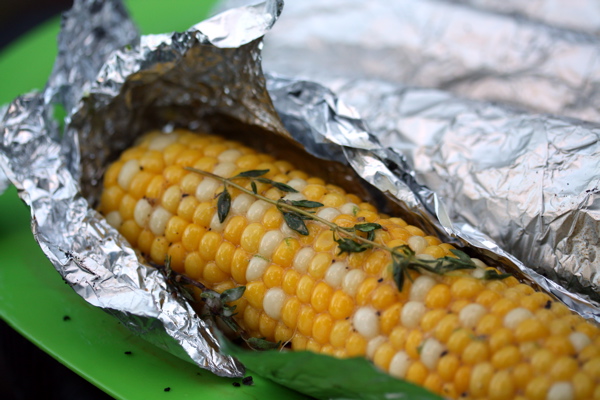
Foil-Grilled Corn on the Cob with Maple Butter from Fast, Fresh & Green by Susie Middleton
I love this method of grilling corn, because it’s mostly hands-off and it yields corn that’s both juicy and toasty tasting. I shuck the corn and rub it all over with butter. Then I wrap it, along with a few herb sprigs, in foil. The corn goes directly on the grill grate for 15 to 20 minutes (you’ll need to turn it every few minutes). Inside, the corn kernels steam, and they also get yummy patches of browning from the butter.
I’ve served this corn with a lot of different flavored butters, but I think Maple Butter is the most delicious. It tastes like great pancakes for dinner. Kids love this, but if you’re looking for a slightly more sophisticated flavor, the addition of lime zest to the Maple Butter is just the thing. (Either way, be sure the butter is well-softened before mixing in the maple or it will not incorporate.)
Obviously, you can double or triple this recipe if you like.
Serves 4
3 tbsp unsalted butter, softened
2 tsp pure maple syrup
⅛ tsp Kosher salt
½ tsp finely grated lime zest (optional)
4 ears corn, shucked, silks removed
4 tsp unsalted butter
Kosher salt
Freshly ground black pepper
12 to 16 sprigs fresh thyme
1. To make the Maple Butter, combine the 3 tbsp butter, maple syrup, ⅛ tsp salt, and lime zest in a small bowl and mix well with a rubber spatula. Set aside.
2. Preheat a gas grill to medium-high. Arrange four sheets of foil (about 12-in / 30.5-cm square) on your counter. Rub each ear of corn all over with 1 tsp of the butter (you can use a little less if you like). Season the corn with salt and pepper and tuck 3 or 4 herb sprigs around each ear. Roll each ear up tightly in its foil wrapper (tuck the ends of the foil in as you go).
3. Put the ears of corn directly on the grill grate. Grill for 15 to 18 minutes, rolling each ear of corn over (about a quarter turn) every 5 or 6 minutes so that each side of the corn eventually has direct contact with the grate. Unroll a little of the foil and take a peek at each ear, which should have some browning patches. If it doesn’t, rewrap the ear and put it back on the grill (in one of the hottest spots) until browned in places, about 5 minutes more.
4. Remove the corn from the grill and carefully loosen the foil around each ear. Let sit for a few minutes and serve with the Maple Butter for spreading.
Sweet Potato “Mini-Fries” with Limey Dipping Sauce and Spiced Salt from Fast, Fresh & Green by Susie Middleton [see photo in the Fast, Fresh & Green section above]
At our house, we eat these fries right off the baking sheet, doused with a little extra salt (or a little Spiced Salt; see below). They rarely make it to the table, but if they do, they look awfully cute served in individual ramekins. Sometimes we double the recipe (easily done with two sheet pans) and plop the hot pans in front of guests who are sniffing around the kitchen before dinner. We put out a little bowl of the easiest dipping sauce ever and they disappear. One thing you should know: sweet potato oven fries, though they’re addictive and delicious, do not get crispy. They will get crisp around the edges, but they stay moist in the middle. (That’s part of their charm; I assure you, you will still love them.)
The sauce is my quick version of the French sauce called aioli, which is a garlicky mayonnaise usually spiked with lemon. I use good-quality store-bought mayonnaise, lime zest, and lime juice for a fast, sassy sauce that’s just as good on grilled fish or chicken as it is on sweet potato fries.
Serves 3 to 4
1 lb / 455 g unpeeled sweet potatoes (about 2 small)
¼ c / 60 ml extra-virgin olive oil
1 tsp Kosher salt, and more for seasoning
Limey Dipping Sauce:
⅓ c / 65 g mayonnaise
½ tsp finely grated lime zest
1 tbsp fresh lime juice
½ tsp minced fresh garlic
Pinch of Kosher salt
Spiced Salt (optional)
1 tsp Kosher salt
½ tsp sugar
¼ tsp ground cinnamon
¼ tsp ground cumin
¼ tsp ground coriander
¼ tsp paprika
1. Preheat the oven to 475°F / 245°C (Gas Mark 9). Line a large (18-x-13-x-1-in / 45.5-x-33-x-2.5-cm) heavy-duty rimmed sheet pan with a piece of parchment paper.
2. Cut the sweet potatoes crosswise on a slight diagonal into ⅜ in / 9.5-mm-thick slices. (If the sweet potato is very narrow at one end, you can cut slices at a very sharp angle at that end.) Cut each slice lengthwise into sticks between ¼ and ⅜-in / 6.5 and 9.5 mm wide. (They will only be about 2 in / 5 cm long.) Put the sticks in a mixing bowl and combine thoroughly with the olive oil and 1 tsp salt. Spread the sweet potatoes out in one layer on the baking sheet, making sure to scrape all the oil and salt from the bowl onto them.
3. Roast for 20 minutes. Using a spatula, flip the sticks over and continue cooking, flipping once or twice more, until the fries are nicely browned (some in spots, some all over), about 10 minutes more.
4. To make the Limey Dipping Sauce, combine all the ingredients in a small bowl, whisking well to blend. Let sit for 10 to 15 minutes to let the flavors marry.
5. To make the Spiced Salt, stir the salt and all the spices together in a small bowl.
6. Sprinkle some of the spiced salt or more kosher salt on the fries (be generous and do not skip this step!), toss well, and serve with the dipping sauce.
Pizza with Mozzarella and Arugula from Fresh From the Farmers’ Market by Janet Fletcher [see photo in the Fresh from the Farmers’ Market section above]
One evening in Rome, my husband and I decided to have dinner at a pizzeria in Trastevere that had been mentioned in a couple of guidebooks. But when we found it, I groaned: The place was almost empty, and the few diners inside looked like tourists. We closed the guidebook, kept on walkingb and soon came upon a much more appetizing sight: a brightly lit pizzeria with a wood-fired oven, a full house inside and at least 100 more people at sidewalk tables. We sat outside in Rome’s mild night air and ate pizzas so light and thin that you could pick them up and roll them like a burrito. My favorite had nothing on it but cheese and a shower of fresh arugula.
It is probably impossible to re-create these Roman pizzas without a wood-burning oven, but allowing the dough a long, slow rise gives the best possible texture. One ounce of arugula may not seem like much, but it’s enough; think of it as an herb that’s scattered on top at the end.
Makes one 13- to 14-inch pizza that serves 2
For the pizza dough:
1 ½ tsp active dry yeast
¾ c warm water
1 tbsp olive oil
1 tsp salt
Approximately 1 ¾ c unbleached all-purpose flour
For the topping:
2 tbsp extra virgin olive oil
1 large garlic clove, minced
¼ tsp hot red pepper flakes
Salt
½ pound low-moisture whole-milk mozzarella, coarsely grated
1 oz arugula
Cornmeal, for dusting
1. To make the dough, sprinkle yeast over warm water in a large bowl and let stand 2 minutes. Stir with a fork to blend. Let stand until bubbling, about 10 minutes.
2. Whisk in olive oil and salt. Add 1½ cups flour, stirring with a wooden spoon.
3. Turn dough out onto a lightly floured board and knead until dough is smooth and elastic, 6 to 8 minutes, using as much of the remaining ¼ cup flour as needed to keep dough from sticking to the board or your hands. Shape into a ball, transfer to an oiled bowl, turn dough to coat with oil, then cover tightly with plastic wrap and let rise 2 hours.
4. Punch dough down, reshape into a ball, re-cover the bowl, and let dough rise again for 4 hours.
5. Position a rack in the center of the oven. Line rack with baking tiles or a baking stone. Preheat to 550°F or the oven’s highest setting for at least 45 minutes. Punch dough down and turn it out onto a work surface. Shape into a ball. Cover with a clean dish towel and let rest 30 minutes.
6. To make the topping, in a small bowl, combine olive oil, garlic, hot pepper flakes, and salt (to taste). Let stand 30 minutes to marry flavors.
7. To assemble pizza, on a lightly floured surface, roll out dough into a 13- to 14-inch round. Transfer to a pizza peel or rimless baking sheet well dusted with cornmeal. Working quickly, spread cheese evenly over the pizza dough, leaving a ¾-inch rim. (If you don’t work quickly, the dough may stick to the peel or sheet.) Brush the rim with some of the seasoned oil, then drizzle more oil, including the garlic and pepper flakes, over the pizza. Reserve a little oil for brushing on the rim after baking.
8. Immediately slide the pizza from peel onto oven tiles or stone and bake until crust is crisp and browned, about 8 minutes. Remove from oven. Scatter arugula over the top. Brush rim of crust with remaining olive oil. Serve immediately.
Complimentary review copies of all of the above cookbooks, except Farm to Fork: Cooking Local, Cooking Fresh, were provided to me by the publishers. I received no compensation from anyone connected with the creation or publishing of any of the books. My opinions are my own.
Thank you to my adventurous recipe testers and tasters, Jan, John, Chad, Sheri, and my perpetually patient husband for sharing their time, feedback, kitchens, gardens, and CSA produce.

Speaking of Lucia Watson and Beth Dooley, their now-16-year-old Savoring the Seasons of the Northern Heartland was promoting the local/organic/seasonal cooking thing long before it became fashionable, and it’s still one of my favorite cookbooks.
This is fantastic, thank you!! I love the compare/contrast aspect of this; it’s so much more helpful than the list & brief description format that’s so common when talking about the # best books of suchandsuch a category. I had written off Fresh, Fast and Green but am definitely reconsidering now. Thanks again.
3 more to consider (actually written by Minnesotans) –
The Minnesota Homegrown Cookbook
Tastes from Valley to Bluff – The Featherstone Farm Cookbook
Angry Trout Cafe Notebook